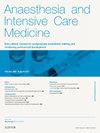Clinical aspects of coagulation and haemorrhage
IF 0.2
Q4 ANESTHESIOLOGY
引用次数: 0
Abstract
Haemorrhage affects all patient groups. Coagulopathy (an abnormality of the clotting system) is closely interlinked with haemorrhage and can either place patients at risk of future bleeding or can exacerbate active ongoing bleeding. There are many causes of coagulopathy – both inherited and acquired. During major haemorrhage, the presence of an acquired coagulopathy increases the likelihood of a poor clinical outcome, and a patient is more likely to require large transfusion volumes, critical care admission and is three to four times more likely to die. Other forms of coagulopathy, such as drug-induced coagulopathy (anticoagulant/anti-platelet use), liver disease or inherited bleeding disorders, both increase the severity of any active bleeding and place patients at higher risk for future bleeding when exposed to a haemostatic challenge, such as surgery. This risk must be recognized and mitigated. This review focuses on the clinical aspects of coagulation and haemorrhage in all these patient groups.
求助全文
约1分钟内获得全文
求助全文
来源期刊

Anaesthesia and Intensive Care Medicine
ANESTHESIOLOGY-
CiteScore
0.50
自引率
0.00%
发文量
152
期刊介绍:
Anaesthesia and Intensive Care Medicine, an invaluable source of up-to-date information, with the curriculum of both the Primary and Final FRCA examinations covered over a three-year cycle. Published monthly this ever-updating text book will be an invaluable source for both trainee and experienced anaesthetists. The enthusiastic editorial board, under the guidance of two eminent and experienced series editors, ensures Anaesthesia and Intensive Care Medicine covers all the key topics in a comprehensive and authoritative manner. Articles now include learning objectives and eash issue features MCQs, facilitating self-directed learning and enabling readers at all levels to test their knowledge. Each issue is divided between basic scientific and clinical sections. The basic science articles include anatomy, physiology, pharmacology, physics and clinical measurement, while the clinical sections cover anaesthetic agents and techniques, assessment and perioperative management. Further sections cover audit, trials, statistics, ethical and legal medicine, and the management of acute and chronic pain.
 求助内容:
求助内容: 应助结果提醒方式:
应助结果提醒方式:


